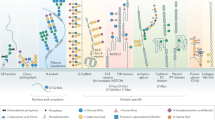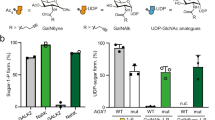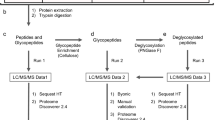Abstract
Glycosylation, the covalent attachment of carbohydrate structures onto proteins, is the most abundant post-translational modification1. Over 50% of human proteins are glycosylated, which alters their activities in diverse fundamental biological processes2,3. Despite the importance of glycosylation in biology4, the identification and functional validation of complex glycoproteins has remained largely unexplored. Here we develop a novel quantitative approach to identify intact glycopeptides from comparative proteomic data sets, allowing us not only to infer complex glycan structures but also to directly map them to sites within the associated proteins at the proteome scale. We apply this method to human and mouse embryonic stem cells to illuminate the stem cell glycoproteome. This analysis nearly doubles the number of experimentally confirmed glycoproteins, identifies previously unknown glycosylation sites and multiple glycosylated stemness factors, and uncovers evolutionarily conserved as well as species-specific glycoproteins in embryonic stem cells. The specificity of our method is confirmed using sister stem cells carrying repairable mutations in enzymes required for fucosylation, Fut9 and Slc35c1. Ablation of fucosylation confers resistance to the bioweapon ricin5,6, and we discover proteins that carry a fucosylation-dependent sugar code for ricin toxicity. Mutations disrupting a subset of these proteins render cells ricin resistant, revealing new players that orchestrate ricin toxicity. Our comparative glycoproteomics platform, SugarQb, enables genome-wide insights into protein glycosylation and glycan modifications in complex biological systems.
This is a preview of subscription content, access via your institution
Access options
Access Nature and 54 other Nature Portfolio journals
Get Nature+, our best-value online-access subscription
$29.99 / 30 days
cancel any time
Subscribe to this journal
Receive 51 print issues and online access
$199.00 per year
only $3.90 per issue
Buy this article
- Purchase on Springer Link
- Instant access to full article PDF
Prices may be subject to local taxes which are calculated during checkout




Similar content being viewed by others
References
Moremen, K. W., Tiemeyer, M. & Nairn, A. V. Vertebrate protein glycosylation: diversity, synthesis and function. Nat. Rev. Mol. Cell Biol. 13, 448–462 (2012)
Goto, Y., Uematsu, S. & Kiyono, H. Epithelial glycosylation in gut homeostasis and inflammation. Nat. Immunol. 17, 1244–1251 (2016)
Dennis, J. W., Lau, K. S., Demetriou, M. & Nabi, I. R. Adaptive regulation at the cell surface by N-glycosylation. Traffic 10, 1569–1578 (2009)
Varki, A. Biological roles of glycans. Glycobiology 27, 3–49 (2017)
Elling, U. et al. Forward and reverse genetics through derivation of haploid mouse embryonic stem cells. Cell Stem Cell 9, 563–574 (2011)
Patnaik, S. K. & Stanley, P. Lectin-resistant CHO glycosylation mutants. Methods Enzymol. 416, 159–182 (2006)
Wollscheid, B. et al. Mass-spectrometric identification and relative quantification of N-linked cell surface glycoproteins. Nat. Biotechnol. 27, 378–386 (2009)
Toghi Eshghi, S., Shah, P., Yang, W., Li, X. & Zhang, H. GPQuest: a spectral library matching algorithm for site-specific assignment of tandem mass spectra to intact N-glycopeptides. Anal. Chem. 87, 5181–5188 (2015)
Yin, X. et al. Glycoproteomic analysis of the secretome of human endothelial cells. Mol. Cell. Proteomics 12, 956–978 (2013)
Rauniyar, N. & Yates, J. R., III . Isobaric labeling-based relative quantification in shotgun proteomics. J. Proteome Res. 13, 5293–5309 (2014)
Savitski, M. M., Mathieson, T., Becher, I. & Bantscheff, M. H-score, a mass accuracy driven rescoring approach for improved peptide identification in modification rich samples. J. Proteome Res. 9, 5511–5516 (2010)
Elias, J. E. & Gygi, S. P. Target-decoy search strategy for increased confidence in large-scale protein identifications by mass spectrometry. Nat. Methods 4, 207–214 (2007)
Ghosh, P., Dahms, N. M. & Kornfeld, S. Mannose 6-phosphate receptors: new twists in the tale. Nat. Rev. Mol. Cell Biol. 4, 202–212 (2003)
Zielinska, D. F., Gnad, F., Wis´niewski, J. R. & Mann, M. Precision mapping of an in vivo N-glycoproteome reveals rigid topological and sequence constraints. Cell 141, 897–907 (2010)
Zhao, P., Stalnaker, S. H. & Wells, L. Approaches for site mapping and quantification of O-linked glycopeptides. Methods Mol. Biol. 951, 229–244 (2013)
Hart, G. W., Housley, M. P. & Slawson, C. Cycling of O-linked β-N-acetylglucosamine on nucleocytoplasmic proteins. Nature 446, 1017–1022 (2007)
Jang, H. et al. O-GlcNAc regulates pluripotency and reprogramming by directly acting on core components of the pluripotency network. Cell Stem Cell 11, 62–74 (2012)
Myers, S. A., Panning, B. & Burlingame, A. L. Polycomb repressive complex 2 is necessary for the normal site-specific O-GlcNAc distribution in mouse embryonic stem cells. Proc. Natl Acad. Sci. USA 108, 9490–9495 (2011)
Ginis, I. et al. Differences between human and mouse embryonic stem cells. Dev. Biol. 269, 360–380 (2004)
Satomaa, T. et al. The N-glycome of human embryonic stem cells. BMC Cell Biol. 10, 42 (2009)
Nairn, A. et al. Changes in glycan-related gene transcripts following human embryonic stem cell differentiation into cell types derived from ectoderm, mesoderm or endoderm lineages. Glycobiology 22, 1590 (2012)
Nairn, A. V. et al. Regulation of glycan structures in murine embryonic stem cells: combined transcript profiling of glycan-related genes and glycan structural analysis. J. Biol. Chem. 287, 37835–37856 (2012)
Yagi, H., Yanagisawa, M., Kato, K. & Yu, R. K. Lysosome-associated membrane protein 1 is a major SSEA-1-carrier protein in mouse neural stem cells. Glycobiology 20, 976–981 (2010)
Taubenschmid, J . et al. A vital sugar code for ricin toxicity. Cell Res. (in the press)
Hellbusch, C. C. et al. Golgi GDP-fucose transporter-deficient mice mimic congenital disorder of glycosylation IIc/leukocyte adhesion deficiency II. J. Biol. Chem. 282, 10762–10772 (2007)
Lu, L., Hou, X., Shi, S., Körner, C. & Stanley, P. Slc35c2 promotes Notch1 fucosylation and is required for optimal Notch signaling in mammalian cells. J. Biol. Chem. 285, 36245–36254 (2010)
Thompson, A. et al. Tandem mass tags: a novel quantification strategy for comparative analysis of complex protein mixtures by MS/MS. Anal. Chem. 75, 1895–1904 (2003)
Probst, O. C. et al. The mannose 6-phosphate/insulin-like growth factor II receptor restricts the tumourigenicity and invasiveness of squamous cell carcinoma cells. Int. J. Cancer 124, 2559–2567 (2009)
Probst, O. C. et al. The mannose 6-phosphate-binding sites of M6P/IGF2R determine its capacity to suppress matrix invasion by squamous cell carcinoma cells. Biochem. J. 451, 91–99 (2013)
Foxwell, B. M. J., Donovan, T. A., Thorpe, P. E. & Wilson, G. The removal of carbohydrates from ricin with endoglycosidases H, F and D and α-mannosidase. Biochim. Biophys. Acta 840, 193–203 (1985)
Varki, A. et al. Symbol nomenclature for graphical representations of glycans. Glycobiology 25, 1323–1324 (2015)
Lee, J., Sundaram, S., Shaper, N. L., Raju, T. S. & Stanley, P. Chinese hamster ovary (CHO) cells may express six β4-galactosyltransferases (β4GalTs). Consequences of the loss of functional β4GalT-1, β4GalT-6, or both in CHO glycosylation mutants. J. Biol. Chem. 276, 13924–13934 (2001)
Pabst, M. et al. Comparison of fluorescent labels for oligosaccharides and introduction of a new postlabeling purification method. Anal. Biochem. 384, 263–273 (2009)
Taus, T. et al. Universal and confident phosphorylation site localization using phosphoRS. J. Proteome Res. 10, 5354–5362 (2011)
Simmons, B. M. & Russell, J. H. A single affinity column step method for the purification of ricin toxin from castor beans (Ricinus communis). Anal. Biochem. 146, 206–210 (1985)
Acknowledgements
We thank all members of our laboratories for discussions, Life Science Editors for editorial support, M. Novatchkova for RNA sequencing (RNA-seq) analysis, and J. Zuber for CRISPR/Cas9 vectors. K.M. is funded by the Austrian Science Fund (SFB F3402-B03, TRP308-N15, and I1469-B16). J.M.P. is supported by grants from IMBA, the Austrian Academy of Sciences, an ERC Advanced Grant, and an Era of Hope Innovator award. J.S. is a Wittgenstein Prize Fellow.
Author information
Authors and Affiliations
Contributions
J.S., J.T., and J.M.P. conceived the study. J.S. designed and performed glycoproteomics experiments and conceived the bio-informatic analysis algorithm. J.T. performed in vitro cell culture experiments. D.W. provided hESCs and U.E. mESCs. A.G., G.D. and F.D. programmed algorithms for glycoproteomics. L.M. provided Igf2r mutant lines. K.M. supervised glycoproteomics experiments. J.S., J.T., and J.M.P. wrote the manuscript with input from all authors.
Corresponding author
Ethics declarations
Competing interests
The authors declare no competing financial interests.
Additional information
Reviewer Information Nature thanks L. Wells and the other anonymous reviewer(s) for their contribution to the peer review of this work.
Publisher's note: Springer Nature remains neutral with regard to jurisdictional claims in published maps and institutional affiliations.
Extended data figures and tables
Extended Data Figure 1 Identification of N-glycopeptides and N-glycans.
a, Glycopeptide MS/MS raw data were pre-processed and identified using different MS/MS search engines: Mascot (orange), SEQUEST-HT (blue), and X!Tandem (green). The glycopeptide sequences identified by these algorithms were highly similar, both with respect to identities and to numbers. Data are representative of two independent mESC glycoproteomics experiments with similar results. b, The N-glycosylation sites identified in our study (orange) were mapped to published annotated N-glycosylation sites in Uniprot (grey) and those identified in ref. 7 (green). c, Negative-mode MALDI–TOF analysis of 2-aminobenzoic-acid-labelled N-glycans from mESCs directly correlated with the N-glycan profiles identified using our glycoproteomics approach.
Extended Data Figure 2 Quantitative proteomics.
Comparative proteomics of (a) Slc35c1 KO and (b) Fut9 KO versus their respective genetically repaired WT sister mESCs did not show significant changes in the overall protein expression as determined by quantitative proteomics. Differential peptide abundances are represented as scatter plots of the corresponding TMT-reporter ion intensities. Data are representative of two independent mESC glycoproteomics experiments with similar results. c, Coverage of the predicted (RNA-seq) mESC proteome by the quantitative proteomics data set.
Extended Data Figure 3 Stemness of KO mESC lines.
The parental control mESC line AN3.12, as well as mutant Hs2st1, Igf2r, Itgb1, Lamp1, Ly75, Slc39a14 mESC lines, were stained for the prototypic mESC markers Oct4, SSEA-1, and alkaline phosphatase. DAPI (4′,6-diamidino-2-phenylindole) is shown to visualize nuclei. Of note, no obvious growth defects or morphological phenotypes were observed. All mESCs were diploid as determined by Hoechst staining (not shown). Scale bars are indicated. The experiments were repeated three times. Each image is representative of five images.
Supplementary information
Supplementary Figures
This file contains Supplementary Figures 1-8. (PDF 1396 kb)
Supplementary Data
This file contains Supplementary Tables 1-12. (XLSX 12731 kb)
Source data
Rights and permissions
About this article
Cite this article
Stadlmann, J., Taubenschmid, J., Wenzel, D. et al. Comparative glycoproteomics of stem cells identifies new players in ricin toxicity. Nature 549, 538–542 (2017). https://doi.org/10.1038/nature24015
Received:
Accepted:
Published:
Issue Date:
DOI: https://doi.org/10.1038/nature24015
This article is cited by
-
Identification of indocyanine green as a STT3B inhibitor against mushroom α-amanitin cytotoxicity
Nature Communications (2023)
-
pGlycoQuant with a deep residual network for quantitative glycoproteomics at intact glycopeptide level
Nature Communications (2022)
-
A general approach to explore prokaryotic protein glycosylation reveals the unique surface layer modulation of an anammox bacterium
The ISME Journal (2022)
-
Glycoproteomics
Nature Reviews Methods Primers (2022)
-
Glyco-Decipher enables glycan database-independent peptide matching and in-depth characterization of site-specific N-glycosylation
Nature Communications (2022)
Comments
By submitting a comment you agree to abide by our Terms and Community Guidelines. If you find something abusive or that does not comply with our terms or guidelines please flag it as inappropriate.



